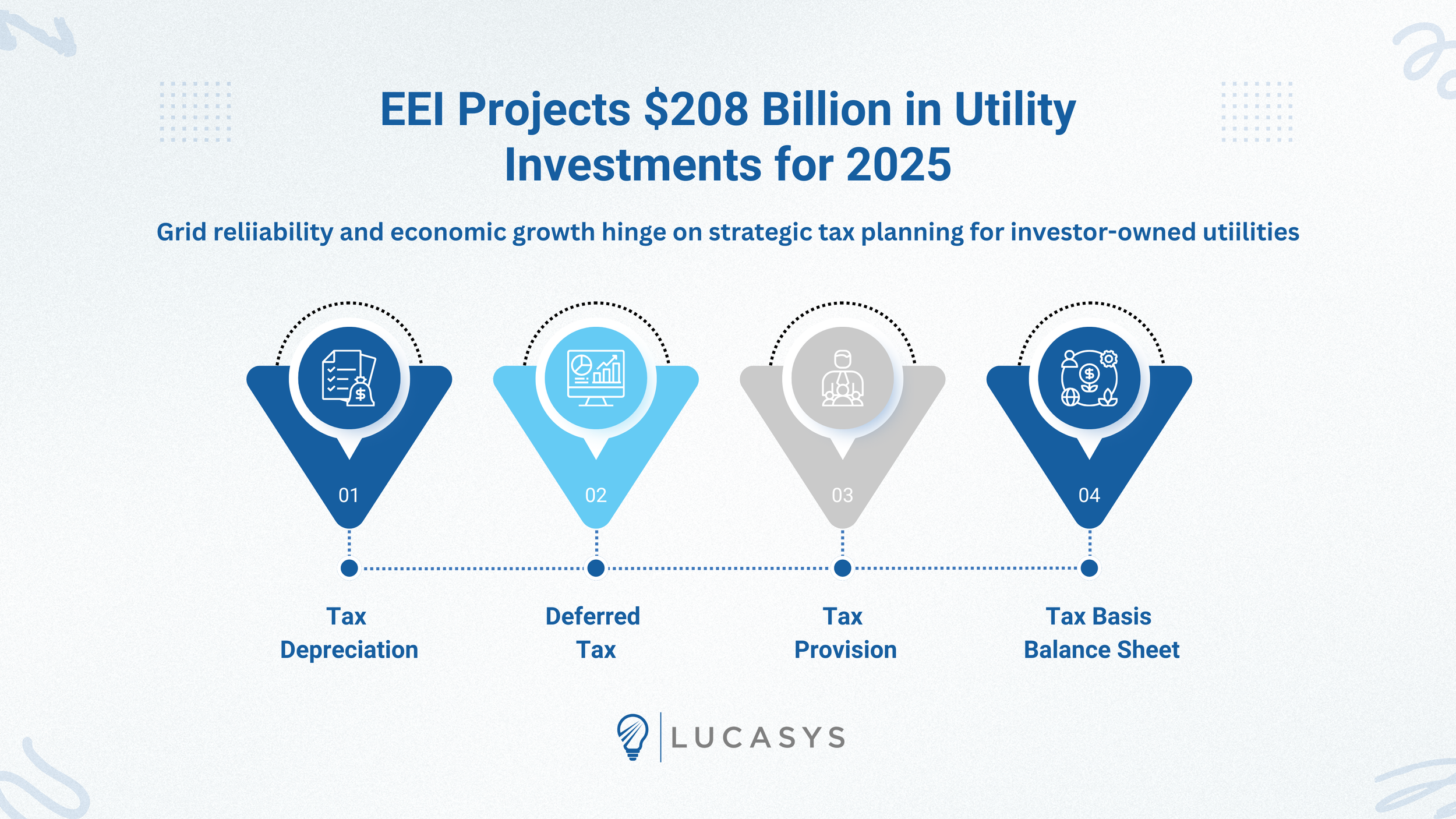EEI Projects Record $208 Billion in Utility Investments for 2025: Why Tax Strategy is Key for Investor-Owned Utilities
Last week, the Edison Electric Institute (EEI) released compelling new data highlighting the massive capital expenditures planned by America's investor-owned electric companies for 2025. According to the report, these companies are projected to invest nearly $208 billion to enhance the nation's energy grid—making it smarter, stronger, more efficient, and more secure. This represents a continuation of robust growth, with electricity generation in the U.S. already up 3% in 2024 and expected to keep rising, driven by increasing demands from electrification, data centers, and AI technologies. Looking further ahead, EEI estimates that investor-owned utilities could pour over $1.1 trillion into infrastructure between 2025 and 2029.
As EEI President and CEO Drew Maloney aptly stated, “Our new data shows how our industry is strengthening the energy grid with real investments—in jobs, critical infrastructure, and communities across the nation. These long-term investments will benefit customers, drive economic growth, and help America achieve energy dominance.” Indeed, with 91 GW of new capacity currently under construction and another 488 GW planned or proposed over the next five years—against the grid's total capacity of about 1,250 GW—these investments are poised to transform the energy landscape. For the nearly 250 million customers relying on these utilities, the payoff includes greater reliability, lower costs as investments spread across a growing customer base, and support for broader economic prosperity.
The Broader Significance: Building a Resilient Future
This level of capital spending underscores the electric industry's pivotal role in powering America's future. As the economy increasingly electrifies—think electric vehicles, smart homes, and industrial automation—the grid must evolve to handle surging demand while maintaining security and efficiency. These investments aren't just about adding capacity; they're about fostering innovation, creating jobs, and positioning the U.S. for energy independence. By strengthening critical infrastructure, utilities are directly contributing to national economic growth, with ripple effects felt in communities nationwide.
However, such ambitious projects come with complex financial considerations. Massive capital outlays mean utilities must navigate intricate regulatory environments, optimize funding sources, and ensure every dollar spent delivers maximum value. This is where strategic tax management becomes indispensable.
Navigating Tax Complexities in a High-Investment Era
For investor-owned utilities (IOUs), these record investments amplify the need for sophisticated strategies around key tax functions: Tax Depreciation, Deferred Tax, Tax Provision, and the Tax Basis Balance Sheet. Here's why each matters and how a proactive approach can turn potential challenges into opportunities:
Tax Depreciation: With billions flowing into new assets like transmission lines, substations, and renewable energy installations, utilities must accurately depreciate these investments to recover costs over time. Accelerated depreciation methods, such as those under the Modified Accelerated Cost Recovery System (MACRS), can provide significant cash flow benefits. With the size of these investments investor owned utilities should strive for the most effective and user-friendly system.
Deferred Tax: Large-scale capex often creates timing differences between book and tax accounting, resulting in deferred tax liabilities or assets. For instance, accelerated depreciation for tax purposes might defer taxes in the short term but requires careful tracking to avoid surprises in future periods. In a rate-regulated environment, managing deferred taxes is crucial for maintaining stable rates and investor confidence, especially as investments scale up.
Tax Provision: Accurate quarterly and annual tax provisions are essential for financial reporting, particularly under ASC 740. With fluctuating investments and regulatory changes—like potential shifts in energy tax credits—utilities need robust forecasting to reflect the true tax impact of their capex. Underestimating provisions can distort earnings, while overestimating ties up capital unnecessarily.
Tax Basis Balance Sheet: Maintaining an up-to-date tax basis for fixed assets is foundational for compliance, M&A activities, and strategic planning. As utilities add hundreds of billions in assets, tracking tax basis ensures proper gain/loss calculations on disposals and supports deferred tax computations. Inaccuracies here can cascade into broader financial and regulatory issues.
In essence, without a cohesive strategy, these tax elements can become silos of inefficiency, increasing audit risks and hindering the ability to reinvest savings back into the grid.
The Value of the Right Tax Partner
This is where having a trusted tax technology partner in your corner makes all the difference. At Lucasys, we specialize in cloud-based solutions tailored for utilities and energy companies, empowering finance, accounting, and tax teams to handle these complexities with precision and ease. Our platform streamlines tax depreciation calculations, automates deferred tax tracking, enhances tax provision accuracy, and maintains a comprehensive tax basis balance sheet—all while ensuring compliance with evolving regulations.
By leveraging our industry expertise and intuitive tools, IOUs can optimize their tax positions, free up capital for further investments, and focus on what they do best: delivering reliable energy. In an era of unprecedented grid modernization, partnering with Lucasys means turning tax management from a burden into a strategic advantage.
As the utility sector charges ahead with these transformative investments, now is the time for IOUs to reassess their tax strategies. Contact us at Lucasys to learn how we can support your journey toward financial optimization and sustained growth.
For more insights on utility tax and finance, visit www.lucasys.com or follow us on LinkedIn.
Ready to see how Lucasys can help you navigate the new era of tax compliance? Visit lucasys.com/solutions to learn more or request a demo today.
How Lucasys Can Help
Lucasys delivers software and technology-enabled services to empower finance, accounting, and tax professionals in asset-intensive industries to optimize the financial performance of their fixed assets and proactively meet changing regulatory and compliance requirements. With a core focus on rate-regulated utilities, Lucasys provides the industry and domain expertise utilities require to meet their business objectives. To learn more about Lucasys, visit https://www.lucasys.com or follow us on LinkedIn.


